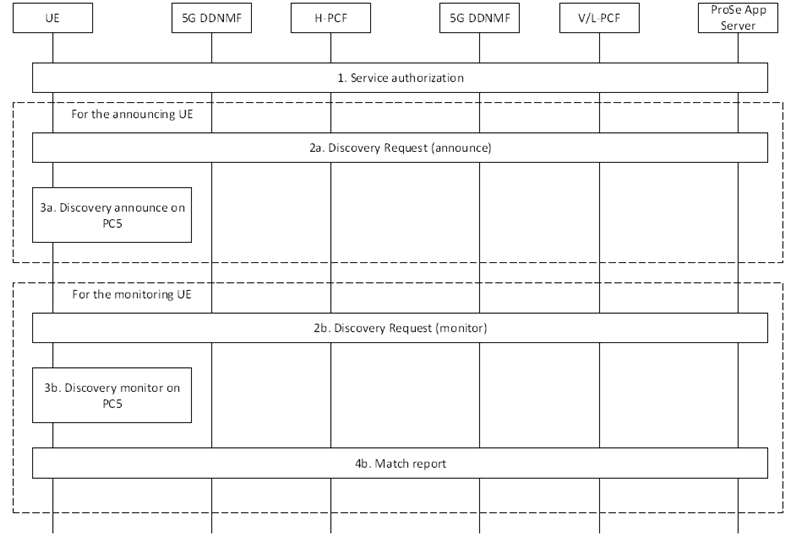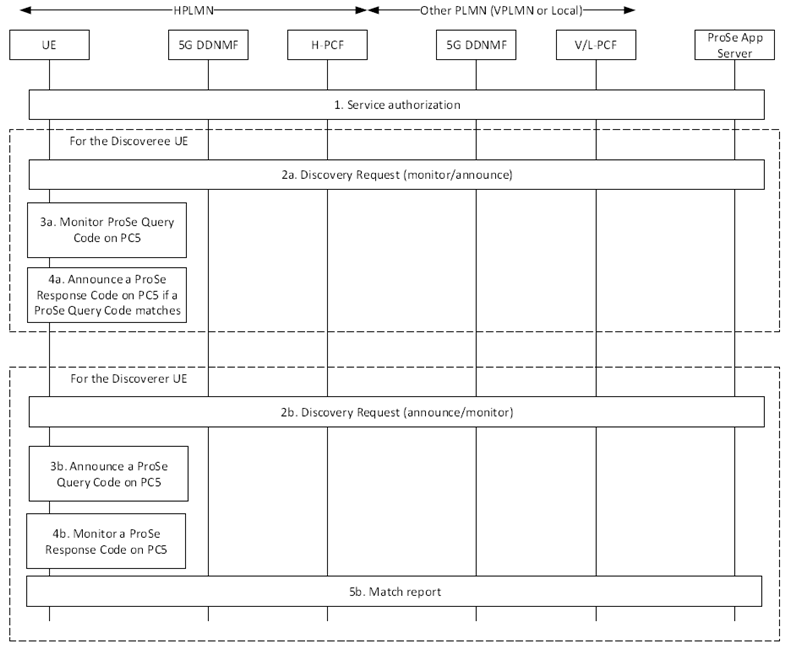Content for TS 23.304 Word version: 19.0.0
1…
4…
4.2.3…
4.2.7…
4.3…
5…
5.1.4…
5.1.5…
5.2…
5.3…
5.4…
5.5…
5.6…
5.7
5.8…
5.9…
6…
6.1.2…
6.2…
6.3…
6.3.2…
6.3.2.3…
6.3.2.4…
6.4…
6.4.3…
6.5…
6.5.2…
6.6…
6.7…
6.7.2…
6.8…
7…
7.2…
6.3 5G ProSe Direct Discovery
6.3.1 5G ProSe Direct Discovery with 5G DDNMF
6.3.1.1 Overview
6.3.1.2 Overall procedure for 5G ProSe Direct Discovery (Model A)
6.3.1.3 Overall procedure for 5G ProSe Direct Discovery (Model B)
6.3.1.4 Discovery Request procedures
6.3.1.5 Discovery Reporting procedures
6.3.1.6 Announcing Alert Procedures for restricted discovery
6.3.1.7 Direct Discovery Update Procedures
...
...
6.3 5G ProSe Direct Discovery p. 81
6.3.1 5G ProSe Direct Discovery with 5G DDNMF p. 81
6.3.1.1 Overview p. 81
5G ProSe Direct Discovery is defined as the process that detects and identifies another UE in proximity using NR radio signals. There are two types of 5G ProSe Direct Discovery supported over PC3a reference point: open and restricted, as defined in TS 23.303. 5G ProSe Direct Discovery can be a standalone service or can be used for subsequent actions e.g. to initiate 5G ProSe Direct Communication.
ProSe-enabled UEs which have obtained authorization to participate in 5G ProSe Direct Discovery shall not continue in participating in 5G ProSe Direct Discovery procedures over PC3a reference point defined in clause 6.3.1 when they detect loss of NG-RAN coverage in the serving PLMN.
With 5G ProSe Direct Discovery, the UE can use inter-PLMN discovery transmission based on the indication from the serving NG-RAN or the provisioned radio resource on the UE. How the serving cell authorizes the UE to use inter-PLMN radio resource is specified in TS 38.331.
6.3.1.2 Overall procedure for 5G ProSe Direct Discovery (Model A) p. 82

Figure 6.3.1.2-1: Overall procedure for Model A 5G ProSe Direct Discovery
(⇒ copy of original 3GPP image)
(⇒ copy of original 3GPP image)
This procedure is applied for open and restricted 5G ProSe Direct Discovery when the ProSe enabled UE is served by NG-RAN.
Step 1.
If the UE is authorised to announce:
Service authorisation for 5G ProSe Direct Discovery services is performed for as defined in clause 6.2.
Step 2a.
If the UE is authorised to monitor:
When the UE is triggered to announce, then it sends a discovery request for announcing to the 5G DDNMF in HPLMN as defined in clause 6.3.1.4. In addition, for restricted 5G ProSe Direct Discovery, the 5G DDNMF further interacts with the ProSe Application server for the authorization of the discovery request.
Step 3a.
If the request is successful and is provided with ProSe Application Code/ProSe Restricted Code, it starts announcing on PC5 interface.
For ProSe restricted discovery and UE requests "on demand" announcing, ProSe Restricted Code may be provided to UE after this procedure. In this case, UE waits for the ProSe Restricted Code allocation and starts to announce the ProSe Restricted Code on PC5 after receiving it in Announcing Alert procedure specified in clause 6.3.1.6.
Step 2b.
Non-roaming direct discovery procedures cover the case where both the "announcing UE" and "monitoring UE" are served by their respective HPLMN. Roaming direct discovery procedures cover the other cases.
When the UE is triggered to monitor, it sends a discovery request for monitoring to the 5G DDNMF as defined in clause 6.3.1.4. In addition, for restricted 5G ProSe Direct Discovery, the 5G DDNMF further interacts with the ProSe Application server for the authorization of the discovery request.
Step 3b.
If the request is successful and the UE is provided with a Discovery Filter consisting of ProSe Application Code(s)/ProSe Restricted Code(s) and/or ProSe Application Mask(s), it starts monitoring for these ProSe Application Codes/ProSe Restricted Codes on the PC5 interface.
Step 4b.
When the UE detects that one or more ProSe Application Code(s)/ProSe Restricted Code(s) that match the filter (see clause 5.8.1), it reports the ProSe Application Code(s)/ProSe Restricted Code(s) to the 5G DDNMF as defined in clause 6.3.1.5.
6.3.1.3 Overall procedure for 5G ProSe Direct Discovery (Model B) p. 83

Figure 6.3.1.3-1: Overall procedure for Model B 5G ProSe Direct Discovery
(⇒ copy of original 3GPP image)
(⇒ copy of original 3GPP image)
This procedure is applied for restricted 5G ProSe Direct Discovery when the ProSe enabled UE is served by NG-RAN.
Step 1.
If the UE is authorised to perform restricted 5G ProSe Direct Discovery, Model B, as a Discoveree UE, the following steps take place:
Service authorisation for 5G ProSe Direct Discovery services is performed as defined in clause 6.2.
Step 2a.
If the UE is authorised to perform restricted 5G ProSe Direct Discovery, Model B, as a Discoverer UE, the following steps take place:
When the UE is triggered to perform restricted 5G ProSe Direct Discovery, Model B, it sends a discovery request to the 5G DDNMF in the HPLMN to obtain a ProSe Response Code as defined in clause 6.3.1.4. The 5G DDNMF further interacts with ProSe Application Server for the authorization of the discovery request.
Step 3a.
If the request is successful and the UE is provided with a ProSe Response Code and an associated Discovery Query Filter(s), then the UE starts monitoring for the ProSe Query Code on PC5 interface.
Step 4a.
If a received ProSe Query Code matches any of the Discovery Query Filter(s), the UE announces the associated ProSe Response Code on the PC5 interface.
Step 2b.
Non-roaming direct discovery procedures cover the case where both the Discoveree UE and Discoverer UE are served by their respective HPLMN. Roaming direct discovery procedures cover the other cases.
When the UE is triggered to perform restricted 5G ProSe Direct Discovery, Model B, it sends a discovery request to the 5G DDNMF in the HPLMN for a ProSe Query Code as defined in clause 6.3.1.4. The 5G DDNMF further interacts with ProSe Application Server for the authorization of the discovery request.
Step 3b.
If the request is successful and the UE is provided with a ProSe Query Code and the Discovery Response Filter(s) consisting of ProSe Response Code(s) and ProSe Application Mask(s), the UE announces the ProSe Query Code on the PC5 interface.
Step 4b.
The UE starts to monitor on PC5 interface for any ProSe Response Code(s) that might match the Discovery Response Filter(s).
Step 5b.
When the UE detects a match for one or more ProSe Response Code(s), it reports the ProSe Response Code to the 5G DDNMF as defined in clause 6.3.1.5.
6.3.1.4 Discovery Request procedures p. 84
The Discovery Request procedure can be used by the "announcing UE" or "monitoring UE" in order to be authorised to access the discovery resources and perform 5G ProSe Direct Discovery. The exact signalling procedures involving the UE, the 5G DDNMFs and the ProSe Application Server are specified in clause 5.3.3 of TS 23.303, with the following modifications:
- the 5G DDNMF takes the role of "ProSe Function" in the procedure;
-
Upon receiving a Discovery Request for restricted discovery from a UE, if the 5G DDNMF does not have a valid PDUID for that UE, the 5G DDNMF searches the PCF for the UE using Nbsf_
Management_ Request and BSF provides the address of the PCF for the UE in Nbsf_Subscribe Management_ Response as defined in the clause 5.2.13.2.6 of TS 23.502. The 5G DDNMF gets the PDUID and subscribes to notifications on Change of PDUID using Npcf_Subscribe AMPolicyAuthorization_ from the PCF for the UE as defined in the clause 5.2.5.8.6 of TS 23.502, including the SUPI, Event ID set to "Change of PDUID" and immediate reporting flag to indicate that the current PDUID value should be provided to the consumer. The PCF provides the PDUID and its validity timer.Subscribe -
At the time the PCF generates a new PDUID, if the subscription to "Change of PDUID" is active it sends Npcf_
AMPolicyAuthorization_ to the 5G DDNMF to report a new PDUID and its validity timer.Notify - the HSS is replaced by UDM;
- the E-UTRAN is replaced by NG-RAN and E-UTRA is replaced with NR;
- corresponding 5GS identifiers replace the EPS identifiers, e.g. use SUPI instead of IMSI and use GPSI instead of MSISDN;
- PC5_tech parameter is omitted and the intended PC5 radio technology is NR.
6.3.1.5 Discovery Reporting procedures p. 85
The Discovery Reporting procedure can be used by the "monitoring UE" (in Model A) and Discoverer UE (in Model B) to request the 5G DDNMF to resolve a matched ProSe Discovery Code(s) (ProSe Application Code for open discovery and ProSe Restricted Code for restricted discovery) and obtain the corresponding ProSe Application ID(s) or RPAUID and additional information, e.g. metadata.
The signalling procedures for the "monitoring UE" (in Model A) is specified in clause 5.3.4 of TS 23.303 and the signalling procedures for the Discoverer UE (in Model B) is specified in clause 5.3.4A of TS 23.303, with the following modifications:
- the 5G DDNMF takes the role of "ProSe Function" in the procedure;
- the HSS is replaced by UDM;
- corresponding 5GS identifiers replace the EPS identifiers, e.g. use SUPI instead of IMSI and use GPSI instead of MSISDN;
- PC5_tech parameter is omitted and the intended PC5 radio technology is NR.
6.3.1.6 Announcing Alert Procedures for restricted discovery p. 85
When supported by the 5G DDNMF and the UE, the Announcing Alert procedure allows the 5G DDNMF to postpone the ProSe Restricted Code allocation, so that the announcing UE would be only triggered by this procedure to announce when the 5G DDNMF receives a Monitor Request from a UE in the vicinity of the announcing UE. This procedure is an optional step of the Discovery Request procedure defined in clause 6.3.1.4.
The signalling procedure of Announcing Alert Procedure is specified in clause 5.3.5 of TS 23.303, with the same modifications listed in clause 6.3.1.4.
6.3.1.7 Direct Discovery Update Procedures p. 85
The 5G DDNMF can at any time update/revoke a previously allocated ProSe Application Code, or Discovery Filters. The UE can decide at any time to stop announcing a ProSe Application Code or monitoring set of Discovery Filter(s). The Direct Discovery Update procedure as specified in clause 5.3.6A.1 of TS 23.303 allows both the 5G DDNMF and the UE to update or revoke the previously authorized discovery. In the defined signalling procedures, the 5G DDNMF(s) takes the role of the "ProSe Function".
A user may decide at any time to change the discovery permissions relating to other users in a ProSe Application Server; then the corresponding ProSe Application Server triggers the procedure as specified in clause 5.3.6A.2 of TS 23.303 towards the affected 5G DDNMF(s) to update/revoke the discovery permissions. In the defined signalling procedures, the 5G DDNMF(s) takes the role of the "ProSe Function".